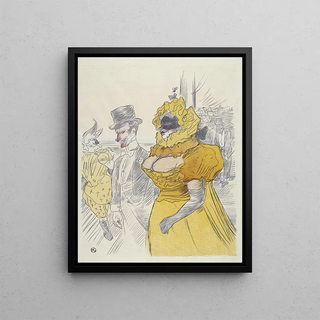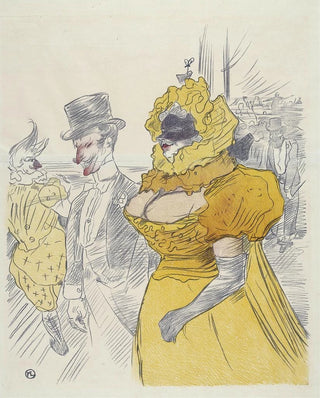Art print | Poster at the Student Ball - Henri de Toulouse-Lautrec Source: Reproduction | Affiche Au Bal des Étudiants - Henri de Toulouse-Lautrec


View from behind

Frame (optional)
The "Au Bal des Étudiants" art print by Henri de Toulouse-Lautrec is an iconic piece that captures the vibrant essence of Parisian nightlife at the end of the 19th century. With a single glance, this work transports us into the effervescent world of popular balls, where dance, music, and joie de vivre blend in a colorful harmony. The artist's mastery in the use of shapes and colors invites us to explore a world where celebration and art meet, revealing the richness of French culture of that era. This art print of the poster, while preserving the authenticity of the original work, allows everyone to immerse themselves in this festive atmosphere and appreciate Lautrec's genius.
Style and uniqueness of the work
The "Au Bal des Étudiants" art print stands out for its bold style and dynamic composition. Toulouse-Lautrec, with his innovative approach, uses flowing lines and vibrant colors to create a scene that is both lively and captivating. The characters, depicted with striking expressiveness, seem to come to life, inviting the viewer to join the dance. The way the artist plays with shadows and lights adds remarkable depth to the piece, thus enhancing the impression of movement and joy. This unique style, which combines realism with a touch of expressionism, makes this art print a perfect example of Belle Époque art. Furthermore, the typography chosen for the title also contributes to the visual impact of the work, emphasizing the importance of the event it promotes.
The artist and his influence
Henri de Toulouse-Lautrec, an emblematic figure of modern art, was able to capture the spirit of his time with unparalleled sensitivity. Coming from an aristocratic family, he chose to immerse himself in the popular milieu of Montmartre, where he found inspiration among artists, dancers, and prostitutes who populated Parisian cabarets. His work, marked by keen observation of social mores, bears witness to an era where the city

Matte finish

View from behind

Frame (optional)
The "Au Bal des Étudiants" art print by Henri de Toulouse-Lautrec is an iconic piece that captures the vibrant essence of Parisian nightlife at the end of the 19th century. With a single glance, this work transports us into the effervescent world of popular balls, where dance, music, and joie de vivre blend in a colorful harmony. The artist's mastery in the use of shapes and colors invites us to explore a world where celebration and art meet, revealing the richness of French culture of that era. This art print of the poster, while preserving the authenticity of the original work, allows everyone to immerse themselves in this festive atmosphere and appreciate Lautrec's genius.
Style and uniqueness of the work
The "Au Bal des Étudiants" art print stands out for its bold style and dynamic composition. Toulouse-Lautrec, with his innovative approach, uses flowing lines and vibrant colors to create a scene that is both lively and captivating. The characters, depicted with striking expressiveness, seem to come to life, inviting the viewer to join the dance. The way the artist plays with shadows and lights adds remarkable depth to the piece, thus enhancing the impression of movement and joy. This unique style, which combines realism with a touch of expressionism, makes this art print a perfect example of Belle Époque art. Furthermore, the typography chosen for the title also contributes to the visual impact of the work, emphasizing the importance of the event it promotes.
The artist and his influence
Henri de Toulouse-Lautrec, an emblematic figure of modern art, was able to capture the spirit of his time with unparalleled sensitivity. Coming from an aristocratic family, he chose to immerse himself in the popular milieu of Montmartre, where he found inspiration among artists, dancers, and prostitutes who populated Parisian cabarets. His work, marked by keen observation of social mores, bears witness to an era where the city






